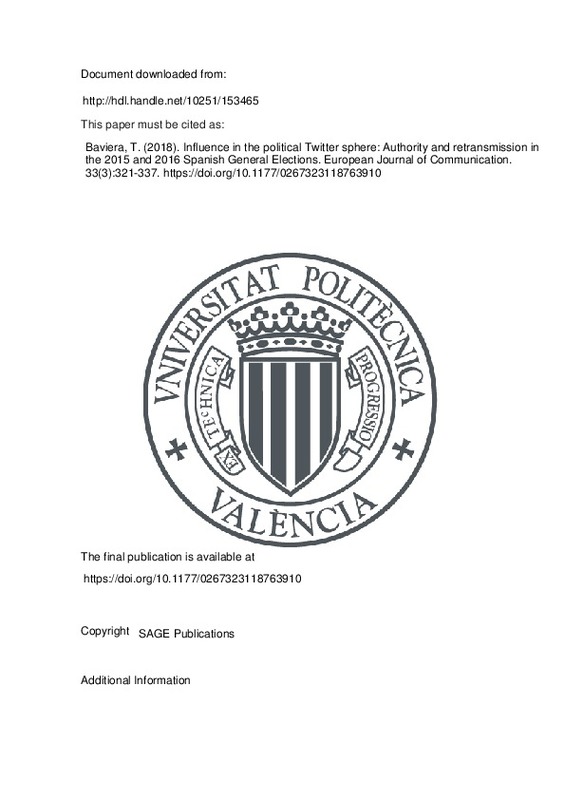Barberá, P., Jost, J. T., Nagler, J., Tucker, J. A., & Bonneau, R. (2015). Tweeting From Left to Right. Psychological Science, 26(10), 1531-1542. doi:10.1177/0956797615594620
Blondel, V. D., Guillaume, J.-L., Lambiotte, R., & Lefebvre, E. (2008). Fast unfolding of communities in large networks. Journal of Statistical Mechanics: Theory and Experiment, 2008(10), P10008. doi:10.1088/1742-5468/2008/10/p10008
Bonacich, P. (1972). Factoring and weighting approaches to status scores and clique identification. The Journal of Mathematical Sociology, 2(1), 113-120. doi:10.1080/0022250x.1972.9989806
[+]
Barberá, P., Jost, J. T., Nagler, J., Tucker, J. A., & Bonneau, R. (2015). Tweeting From Left to Right. Psychological Science, 26(10), 1531-1542. doi:10.1177/0956797615594620
Blondel, V. D., Guillaume, J.-L., Lambiotte, R., & Lefebvre, E. (2008). Fast unfolding of communities in large networks. Journal of Statistical Mechanics: Theory and Experiment, 2008(10), P10008. doi:10.1088/1742-5468/2008/10/p10008
Bonacich, P. (1972). Factoring and weighting approaches to status scores and clique identification. The Journal of Mathematical Sociology, 2(1), 113-120. doi:10.1080/0022250x.1972.9989806
Casero-Ripollés, A., Feenstra, R. A., & Tormey, S. (2016). Old and New Media Logics in an Electoral Campaign. The International Journal of Press/Politics, 21(3), 378-397. doi:10.1177/1940161216645340
Chadwick, A. (2013). The Hybrid Media System. doi:10.1093/acprof:oso/9780199759477.001.0001
Colleoni, E., Rozza, A., & Arvidsson, A. (2014). Echo Chamber or Public Sphere? Predicting Political Orientation and Measuring Political Homophily in Twitter Using Big Data. Journal of Communication, 64(2), 317-332. doi:10.1111/jcom.12084
Congosto, M. L. (2015). European Elections 2014: Virality of messages on Twitter. Redes. Revista hispana para el análisis de redes sociales, 26(1), 23. doi:10.5565/rev/redes.529
Conway, B. A., Kenski, K., & Wang, D. (2015). The Rise of Twitter in the Political Campaign: Searching for Intermedia Agenda-Setting Effects in the Presidential Primary. Journal of Computer-Mediated Communication, 20(4), 363-380. doi:10.1111/jcc4.12124
Dang-Xuan, L., Stieglitz, S., Wladarsch, J., & Neuberger, C. (2013). AN INVESTIGATION OF INFLUENTIALS AND THE ROLE OF SENTIMENT IN POLITICAL COMMUNICATION ON TWITTER DURING ELECTION PERIODS. Information, Communication & Society, 16(5), 795-825. doi:10.1080/1369118x.2013.783608
Drezner, D. W., & Farrell, H. (2004). Web of Influence. Foreign Policy, (145), 32. doi:10.2307/4152942
Dubois, E., & Gaffney, D. (2014). The Multiple Facets of Influence. American Behavioral Scientist, 58(10), 1260-1277. doi:10.1177/0002764214527088
Freelon, D., & Karpf, D. (2014). Of big birds and bayonets: hybrid Twitter interactivity in the 2012 Presidential debates. Information, Communication & Society, 18(4), 390-406. doi:10.1080/1369118x.2014.952659
Freeman, L. C. (1977). A Set of Measures of Centrality Based on Betweenness. Sociometry, 40(1), 35. doi:10.2307/3033543
Guo, L., & Vargo, C. (2015). The Power of Message Networks: A Big-Data Analysis of the Network Agenda Setting Model and Issue Ownership. Mass Communication and Society, 18(5), 557-576. doi:10.1080/15205436.2015.1045300
Huckfeldt, R., & Sprague, J. (1987). Networks in Context: The Social Flow of Political Information. American Political Science Review, 81(4), 1197-1216. doi:10.2307/1962585
Huckfeldt, R., & Sprague, J. (1991). Discussant Effects on Vote Choice: Intimacy, Structure, and Interdependence. The Journal of Politics, 53(1), 122-158. doi:10.2307/2131724
Jungherr, A. (2014). The Logic of Political Coverage on Twitter: Temporal Dynamics and Content. Journal of Communication, 64(2), 239-259. doi:10.1111/jcom.12087
Kruikemeier, S. (2014). How political candidates use Twitter and the impact on votes. Computers in Human Behavior, 34, 131-139. doi:10.1016/j.chb.2014.01.025
López García, G., Gamir Ríos, J. V., García Ull, F. J., Llorca Abad, G., Cano Orón, L., & González Esteban, J. L. (2015). El debate sobre Europa en Twitter. Discursos y estrategias de los candidatos de las elecciones al Parlamento Europeo de 2014 en España. Revista de Estudios Políticos, (170), 213-246. doi:10.18042/cepc/rep.170.07
Newman, M. (2010). Networks. doi:10.1093/acprof:oso/9780199206650.001.0001
Park, C. S. (2013). Does Twitter motivate involvement in politics? Tweeting, opinion leadership, and political engagement. Computers in Human Behavior, 29(4), 1641-1648. doi:10.1016/j.chb.2013.01.044
Vergeer, M., & Hermans, L. (2013). Campaigning on Twitter: Microblogging and Online Social Networking as Campaign Tools in the 2010 General Elections in the Netherlands. Journal of Computer-Mediated Communication, 18(4), 399-419. doi:10.1111/jcc4.12023
Wasserman, S., & Faust, K. (1994). Social Network Analysis. doi:10.1017/cbo9780511815478
Watts, D. J., & Strogatz, S. H. (1998). Collective dynamics of ‘small-world’ networks. Nature, 393(6684), 440-442. doi:10.1038/30918
Weimann, G., Tustin, D. H., van Vuuren, D., & Joubert, J. P. R. (2007). Looking for Opinion Leaders: Traditional vs. Modern Measures in Traditional Societies. International Journal of Public Opinion Research, 19(2), 173-190. doi:10.1093/ijpor/edm005
Xu, W. W., Sang, Y., Blasiola, S., & Park, H. W. (2014). Predicting Opinion Leaders in Twitter Activism Networks. American Behavioral Scientist, 58(10), 1278-1293. doi:10.1177/0002764214527091
Zarzalejos, J. (2016). Populism in Spain: An Analysis of Podemos. European View, 15(2), 183-191. doi:10.1007/s12290-016-0408-4
[-]







![[Cerrado]](/themes/UPV/images/candado.png)


